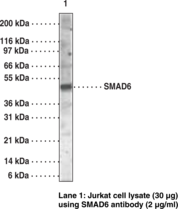| References |
| Formulation |
100 µg protein G-purified in 200 µl PBS containing 0.05% BSA and 0.05% sodium azide |
| Stability |
6 months |
| Storage |
-20°C |
| Shipping |
Wet ice
in continental US; may vary elsewhere
|
| Specificity |
| Human SMAD6 |
(+) |
| New World Monkey SMAD6 |
(+) |
| Murine SMAD6 |
(+) |
| Ovine SMAD6 |
(+) |
| Rat SMAD6 |
(+) |
Show all 5
Hide all but first 3
|
| Size |
Global Purchasing |
| 100 µg |
|
Description
Antigen:
synthetic peptides corresponding to amino acids 85-99 and amino acids 372-388 of human SMAD6
·
Host:
rabbit
·
Application(s):
IHC and WB
·
Peptide sequence:
(RAGGPPRPMSEPGAG) and (NLEQRSESVRRTRSKIG)
·
SMADs are a family of intracellular proteins that are essential components in the signaling pathways of the serine/threonine kinase receptors of the transforming growth factor β superfamily.1 SMADs can be divided into receptor-regulated SMADs (R-SMADs: SMAD1, SMAD2, SMAD3, SMAD5, SMAD8, and SMAD9), common-mediator SMAD (co-SMAD: SMAD4), and inhibitory SMADs (I-SMADs: SMAD6 and SMAD7). SMAD1, SMAD5, SMAD8, and SMAD9 have high degrees of homology and antibodies are available that recognize sequences common to all of them. SMAD8 and SMAD9 are typically used as alternate names for one another in the literature.
1
Kawai, S., Faucheu, S., Gallea, S., et al. Mouse Smad8 phosphorylation downstream of BMP receptors ALK-2, ALK-3, and ALK-6 induces its association with Smad4 and transcriptional activity. Biochem Biophys Res Commun 271(3) 682-7 (2000).
|






